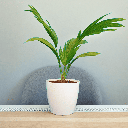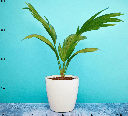Product Specifications
The China Palm Plant, commonly known as the Chinese Fan Palm, is a striking ornamental plant celebrated for its elegant, fan-shaped leaves and its ease of care. This versatile plant features large, deeply divided leaves that arch gracefully, creating a cascading effect that adds a touch of tropical beauty to any space. The slender trunk, often adorned with textured leaf bases, further enhances its visual appeal. Suitable for both indoor and outdoor environments, the China Palm thrives in bright, indirect light and prefers a consistently moist but well-draining soil. It’s an excellent choice for those seeking a low-maintenance plant, as it adapts well to various light conditions and can tolerate occasional neglect.
Beyond its aesthetic appeal, the China Palm offers several practical benefits. It acts as a natural air purifier, filtering out common indoor pollutants and increasing oxygen levels, which contributes to a healthier living environment. Additionally, the plant’s presence can enhance humidity levels, which may alleviate respiratory issues and reduce the discomfort caused by dry indoor air. The China Palm also plays a role in reducing stress and boosting mood, making it an ideal addition to homes, offices, or any space where a calming atmosphere is desired.
Furthermore, the China Palm supports sustainable living, as it actively absorbs carbon dioxide and releases oxygen, contributing positively to the environment. Its longevity makes it a valuable investment, as it can thrive for many years with proper care, becoming a lasting element of your home or garden. Whether placed in a modern living room, a serene office space, or a lush outdoor garden, the China Palm Plant brings both beauty and numerous benefits, making it a cherished choice for plant enthusiasts and novices alike.
1. Filters Pollutants: Like many other palms, the China Palm helps improve indoor air quality by filtering out common pollutants such as formaldehyde, benzene, and carbon monoxide.
2. Increases Oxygen Levels: The plant contributes to a healthier indoor environment by releasing oxygen, which can improve overall well-being.
3. Elegant Appearance: With its large, fan-shaped leaves, the China Palm adds a touch of tropical beauty and sophistication to any space.
4. Versatile Decoration: It’s a versatile plant that can enhance the ambiance of homes, offices, patios, and gardens, complementing a wide range of interior styles.
5. Easy to Care: The China Palm is relatively low-maintenance, making it an excellent choice for both novice and experienced plant owners. It adapts well to various indoor conditions and doesn’t require frequent attention.
6. Resilient: It can tolerate periods of neglect, such as irregular watering, and still thrive, making it a hardy addition to any plant collection.
7. Calming Effect: Studies have shown that being around plants can reduce stress and anxiety. The China Palm’s lush greenery and natural presence can create a calming and serene atmosphere.
8. Improves Mood: The presence of greenery indoors is known to boost mood and productivity, making it a great addition to workspaces.
9. Sustainable Growth: As a living plant, the China Palm contributes positively to the environment by absorbing carbon dioxide and releasing oxygen.
10. Biodiversity Support: In outdoor settings, this plant can attract beneficial insects, birds, and other wildlife, contributing to local biodiversity.
11. Humidifies Air: The plant naturally increases humidity levels in the surrounding environment, which can help reduce respiratory issues, skin dryness, and other discomforts caused by dry indoor air.
12. Allergen Reduction: By trapping dust and other allergens on its leaves, the China Palm can help reduce indoor allergens, leading to a cleaner breathing environment.
With proper care, your plant will thrive and bring beauty to your space. Follow these guidelines to ensure its optimal health and longevity:
1. Light:
- Ideal Light: Place your China Palm in bright, indirect light. It can tolerate lower light conditions, but growth may be slower.
- Avoid Direct Sunlight: Direct sunlight can scorch the leaves, so keep the plant away from harsh, direct sun rays.
2. Watering:
- Spring and Summer: Water once a week. Check the top inch of soil; water when it feels dry. Ensure that water drains out of the bottom of the pot and discard any excess water.
- Fall and Winter: Reduce watering to about once every two weeks. Allow the soil to dry out more between waterings as the plant’s growth slows in cooler months.
- Watering Method: Water thoroughly to ensure the roots receive moisture. Avoid letting the plant sit in standing water to prevent root rot.
3. Humidity:
- Increase Humidity: China Palms prefer higher humidity. Mist the leaves regularly or use a humidity tray to maintain optimal moisture levels.
- Indoor Environment: In dry indoor conditions, consider using a humidifier to keep the air around the plant moist.
4. Soil:
- Well-Draining Soil: Use a well-draining potting mix, such as one designed for palms or a blend of peat, perlite, and sand. Good drainage is crucial to avoid root rot.
5. Temperature:
- Optimal Range: Maintain temperatures between 18-27°C. Avoid exposing the plant to temperatures below 10°C or cold drafts.
6. Fertilizing:
- Growing Season: Feed your China Palm with a balanced, water-soluble fertilizer every 4-6 weeks during spring and summer.
- Reduce Feeding: Cut back on fertilizing during the fall and winter months when the plant’s growth slows.
7. Repotting:
- Frequency: Repot your China Palm every 2-3 years or when it becomes root-bound. Choose a pot that is slightly larger than the current one.
- Repotting Procedure: Gently remove the plant from its pot, loosen any circling roots, and place it in fresh potting soil. Water well after repotting.
8. Pest Management:
- Common Pests: Check regularly for pests such as spider mites and scale insects. Treat any infestations promptly with insecticidal soap or neem oil.
- Monitoring: Keep an eye on the plant’s health and address any issues promptly to maintain its well-being.






